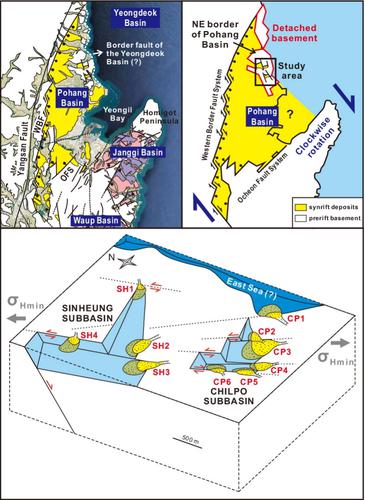当前位置:
X-MOL 学术
›
Basin Res.
›
论文详情
Our official English website, www.x-mol.net, welcomes your feedback! (Note: you will need to create a separate account there.)
Tectono-sedimentary development of early synrift half-graben subbasins in the Miocene Pohang Basin, southeastern Korea
Basin Research ( IF 3.2 ) Pub Date : 2022-07-26 , DOI: 10.1111/bre.12699 Jino Park 1 , Jeong‐Hyun Lee 2 , Jongsun Hong 1
Basin Research ( IF 3.2 ) Pub Date : 2022-07-26 , DOI: 10.1111/bre.12699 Jino Park 1 , Jeong‐Hyun Lee 2 , Jongsun Hong 1
Affiliation

|
Early synrift half-grabens, herein named the Chilpo and Sinheung subbasins, have been newly recognised in the north-central area of the Miocene Pohang Basin, Korea. The subbasins are closely aligned along an array of NNW-trending strike-slip faults and are bounded by ENE-striking normal faults. The sediment infill of the subbasins consists of a deepening- and fining-upward sequence of alluvial cobble to boulder conglomerate (FA1), alluvial to nearshore granule to pebble conglomerate and sandstone (FA2) and hemipelagic mudstone (FA3). The younger strata sequentially onlap the older strata in the hangingwall basement or transfer zones, whereas the footwall basement is directly onlapped by the younger hemipelagic mudstone. These patterns may have resulted from a series of domino-style block rotations, in which subsidence along normal faults caused the differential creation of accommodation space, whilst simultaneous uplift in the upslope of rotated hangingwall blocks controlled denudation, the shedding of sediments to downslope areas and asymmetric stacking of sediments in both subbasins. In contrast to the western margin of the Pohang Basin, where large footwall-derived fan-delta systems developed along the bounding faults, in the Chilpo and Sinheung subbasins, small hangingwall-derived alluvial-fan deltas formed during rifting. The development of these domino-style half-grabens would have resulted from the detachment and simultaneous transrotation of the crustal block away from the northwest during accelerated extension in the Pohang Basin. Recent geophysical studies have detected very thin basin-fill sediments in the north-central Pohang Basin and faults that are similar in orientation to those identified in this study, thereby supporting our observations. These findings confirm the early opening of the Pohang Basin, supporting the hypothesis that all of the Miocene basins in southeastern Korea formed in a setting of NW–SE extension, and further suggest the development of the wedge-shaped transtensional basin, in response to the opening of the East Sea (Sea of Japan) after 17 Ma.
中文翻译:

韩国东南部中新世浦项盆地早同裂谷半地堑次盆地的构造沉积发育
韩国中新世浦项盆地的中北部地区新发现了早期同裂谷半地堑,在此命名为七浦和新兴次盆地。这些子盆地沿着一系列 NNW 走向的走滑断层紧密排列,并以 ENE 走向的正断层为界。次盆地的沉积物充填物由冲积卵石到砾岩砾岩 (FA1)、冲积层到近岸颗粒到砾石砾岩和砂岩 (FA2) 和半远洋泥岩 (FA3) 的加深和细化向上序列组成。在上盘基底或转换带中,较年轻的地层依次超覆较老的地层,而下盘基底直接被较新的半远洋泥岩上覆。这些模式可能是由一系列多米诺骨牌式块旋转产生的,其中,沿正断层的沉降导致可容纳空间的差异化形成,同时旋转上盘块的上坡同时抬升控制了两个子盆地的剥蚀、沉积物向下坡区域的脱落和沉积物的不对称堆积。与浦项盆地西缘沿着边界断层发育大型下盘衍生扇三角洲系统不同,在七浦和新兴次盆地,在裂谷过程中形成了小型上盘衍生冲积扇三角洲。这些多米诺式半地堑的发育可能是浦项盆地加速扩张过程中地壳块从西北方向分离和同时旋转的结果。最近的地球物理研究在浦项盆地中北部发现了非常薄的盆地填充沉积物和与本研究中确定的断层方向相似的断层,从而支持我们的观察。这些发现证实了浦项盆地的早期开放,支持了韩国东南部所有中新世盆地都是在 NW-SE 伸展背景下形成的假设,并进一步表明楔形张拉盆地的发育,以响应17 Ma 后东海(日本海)开放。
更新日期:2022-07-26
中文翻译:

韩国东南部中新世浦项盆地早同裂谷半地堑次盆地的构造沉积发育
韩国中新世浦项盆地的中北部地区新发现了早期同裂谷半地堑,在此命名为七浦和新兴次盆地。这些子盆地沿着一系列 NNW 走向的走滑断层紧密排列,并以 ENE 走向的正断层为界。次盆地的沉积物充填物由冲积卵石到砾岩砾岩 (FA1)、冲积层到近岸颗粒到砾石砾岩和砂岩 (FA2) 和半远洋泥岩 (FA3) 的加深和细化向上序列组成。在上盘基底或转换带中,较年轻的地层依次超覆较老的地层,而下盘基底直接被较新的半远洋泥岩上覆。这些模式可能是由一系列多米诺骨牌式块旋转产生的,其中,沿正断层的沉降导致可容纳空间的差异化形成,同时旋转上盘块的上坡同时抬升控制了两个子盆地的剥蚀、沉积物向下坡区域的脱落和沉积物的不对称堆积。与浦项盆地西缘沿着边界断层发育大型下盘衍生扇三角洲系统不同,在七浦和新兴次盆地,在裂谷过程中形成了小型上盘衍生冲积扇三角洲。这些多米诺式半地堑的发育可能是浦项盆地加速扩张过程中地壳块从西北方向分离和同时旋转的结果。最近的地球物理研究在浦项盆地中北部发现了非常薄的盆地填充沉积物和与本研究中确定的断层方向相似的断层,从而支持我们的观察。这些发现证实了浦项盆地的早期开放,支持了韩国东南部所有中新世盆地都是在 NW-SE 伸展背景下形成的假设,并进一步表明楔形张拉盆地的发育,以响应17 Ma 后东海(日本海)开放。



























 京公网安备 11010802027423号
京公网安备 11010802027423号